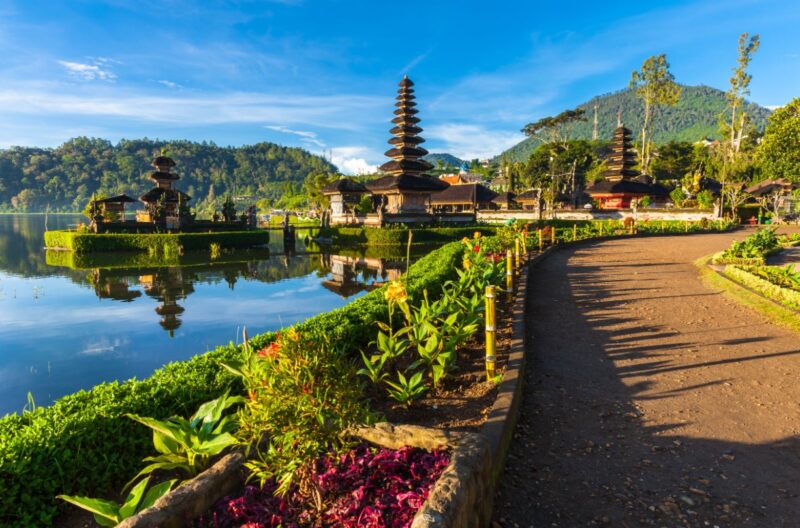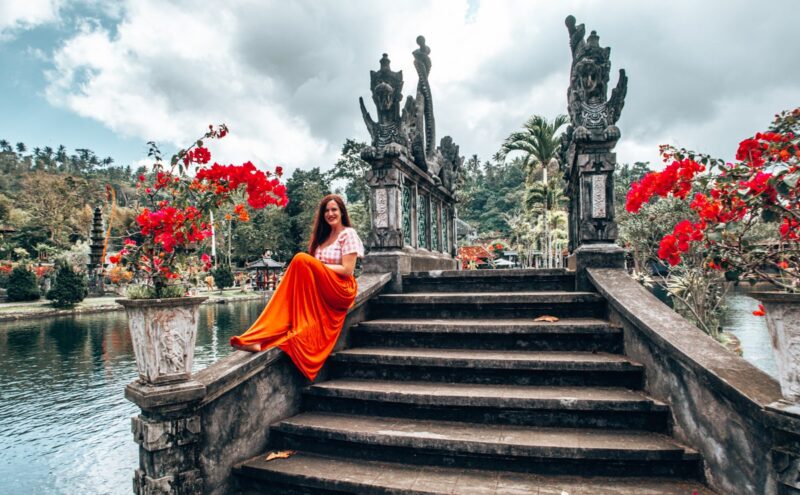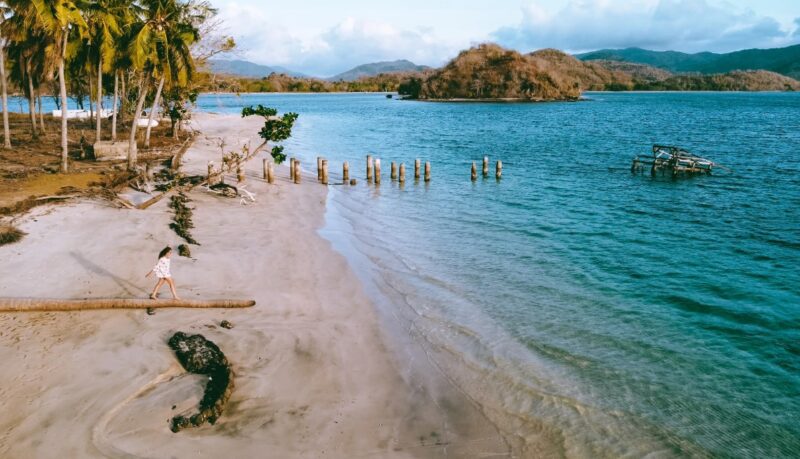Did you know that Indonesia is home to over 17,000 islands, making it the largest archipelago in the world? With its diverse landscapes, rich culture, and tropical climate, it’s no wonder that Indonesia is a popular destination for travelers seeking an unforgettable adventure.
Imagine yourself strolling along white sandy beaches, exploring ancient temples, and diving into crystal-clear waters teeming with vibrant marine life. Whether you’re an avid beachgoer, a nature enthusiast, or a culture lover, Indonesia has something to offer for everyone.
But with so many islands and varied weather patterns, when is the best time to visit Indonesia? In this article, we will provide you with a monthly climate guide and share the ideal months to plan your Indonesia adventure. From the best time to visit Bali to exploring Indonesia in the low season, we’ve got you covered.
Key Takeaways:
- The best time to visit Indonesia is between April and October when the weather is perfect for beach activities and exploring the country.
- May and June offer the advantage of smaller crowds, minimal rain, and potential promotions.
- The peak season falls between July and August, bringing perfect weather but also crowds and higher prices.
- The shoulder seasons from March to June and September to November provide good weather, reduced tourist numbers, and lower prices.
- Traveling during the low season in January and February offers discounted prices and a more relaxed atmosphere, but some activities might be more challenging.
Ideal Months to Visit Indonesia

When planning a trip to Indonesia, it’s important to choose the ideal months for your visit. The weather conditions, crowd size, and promotional offers can vary throughout the year, so it’s essential to consider these factors when making your travel plans.
The perfect time to visit Indonesia is during the months of May and June. This period offers ideal weather conditions, with plenty of sunshine and minimal rainfall. The crowds are also smaller compared to the school vacation period, allowing you to enjoy the attractions and activities with more ease.
Moreover, during these months, many hotels and tour operators offer promotions and discounts as part of the shoulder season deals.
The peak season in Indonesia falls between July and August. This is the most popular time to visit, as it coincides with the European summer holidays and the Australian winter. The weather during this time is perfect for outdoor activities, and you can expect sunny days and warm temperatures.
However, it’s important to note that the peak season also brings larger crowds and higher prices, as it’s the most sought-after time for travelers.
If you prefer to avoid the crowds and the peak season prices, the off-peak travel months in Indonesia are from March to June and September to November. These shoulder seasons offer a balance of good weather and reduced tourist numbers.
You can still enjoy pleasant temperatures and sunshine, while also benefiting from lower prices on accommodations and activities. These months are particularly great for nature enthusiasts, as you can witness amazing natural encounters like observing orangutans or diving with whale sharks.
Ultimately, the best time to visit Indonesia depends on your preferences and priorities. Whether you choose the ideal months for smaller crowds and promotional offers or the peak season for perfect weather and lively atmosphere, Indonesia has something to offer year-round.
It’s important to consider the specific attractions and destinations within Indonesia, as they may have their own unique climate patterns. With careful planning, you can ensure a memorable and enjoyable trip to this beautiful country.
Monthly Climate Guide for Indonesia
The climate in Indonesia varies by month. In January, widespread rain affects the entire country, making it challenging to find sunshine, especially in the south. This month also marks the celebration of Chinese New Year, with traditional festivals taking place across Indonesia. Let’s take a closer look at the temperatures and rainfall in some popular destinations:
Bali
During January, the average temperature in Bali is around 31°C, with a significant amount of rainfall at 252mm. Despite the rain, Bali’s lush landscapes and vibrant culture continue to attract visitors throughout the year.

Jakarta
In Jakarta, January also experiences similar temperatures to Bali, but with slightly higher rainfall. This bustling capital city offers a blend of modernity and Indonesian heritage, making it worth a visit regardless of the weather.
Komodo Island
Komodo Island, known for its famous Komodo dragons, experiences varying temperatures and rainfall throughout the year. In January, temperatures hover around 30°C, accompanied by approximately 200mm of rainfall. Despite the rain, the island’s unique wildlife and breathtaking landscapes make it a must-visit destination.
Lombok
Lombok, an island known for its pristine beaches and rugged beauty, experiences temperatures of around 31°C during January. The rainfall is similar to Bali, with an average of 252mm. Travelers can still explore Lombok’s natural wonders, such as the stunning Mount Rinjani, despite the occasional rain showers.

Sumba
Sumba, a lesser-known island in Indonesia, offers tranquil landscapes and untouched beaches. In January, temperatures reach an average of 29°C, with around 165mm of rainfall. The island’s cultural heritage and unique wildlife make Sumba an off-the-beaten-path gem.
Tanjung Puting National Park
Tanjung Puting National Park is famous for its orangutan conservation efforts. In January, visitors can expect temperatures of around 32°C and approximately 216mm of rainfall. Despite the rain, this is an excellent time to observe orangutans in their natural habitat.
Yogyakarta
Yogyakarta, known for its rich Javanese heritage and iconic temple complexes like Borobudur and Prambanan, experiences similar weather patterns to Jakarta. January temperatures average around 31°C, with slightly higher rainfall.
The cultural and historical treasures found in Yogyakarta can be explored regardless of the rain.
It’s important to note that these climate conditions are specific to January, and Indonesia’s weather can vary considerably throughout the year. When planning your trip, consider the individual destination’s climate and weather patterns to ensure the best possible experience.

Best Time to Visit Bali
If you are planning a trip to Bali, it’s essential to choose the best time to travel to make the most of your experience. The ideal months to visit Bali are during May to June or September.
During these months, Bali boasts perfect weather conditions for enjoying its stunning beaches, surfing the legendary waves, trekking its majestic volcanoes, and immersing yourself in the unique Hindu culture that permeates the island.
Aside from pleasant weather, visiting Bali during May to June or September also has the advantage of smaller crowds compared to the peak tourist season in July and August. You can savor the beauty of Bali’s landscapes and landmarks without feeling overwhelmed by hordes of fellow travelers.
However, it’s important to note that Bali’s weather can be unpredictable at times. It’s always a good idea to check the weather forecast before planning your trip and be prepared for occasional showers even during the drier months.
Overall, the best time to travel to Bali is during May to June or September when you can enjoy the perfect weather, engage in thrilling activities, and experience the cultural richness of the island. Just remember to pack sunscreen, a hat, and your adventurous spirit!
Enjoying Indonesia in the Low Season
The low season in Indonesia, particularly in January and February, offers bargain prices and a more relaxed atmosphere. Although it is the rainy season, the rain usually comes in short, intense downpours followed by clear skies. The low season is a great time to immerse yourself in the local culture, visit temples without crowds, and explore unique destinations like West Papua and Maluku.
However, some activities like hiking and wildlife encounters might be more challenging during this time. It’s recommended to schedule trips during the drier months from April to October if you plan on engaging in outdoor activities.
If you’re looking for a budget-friendly getaway to Indonesia, the low season is the perfect time to plan your trip. With fewer tourists around, you can enjoy discounted prices on accommodation, tours, and flights. This is especially beneficial for travelers who want to explore Indonesia on a limited budget.
While it’s true that the rainy season brings more precipitation, it’s important to note that the rain typically comes in short bursts, allowing plenty of time for outdoor activities. And once the rain clears, you’ll be rewarded with clear skies and stunning landscapes.
View this post on Instagram
“Visiting Indonesia during the low season is a unique experience. You get to see a different side of the country, away from the crowds and with a more laid-back vibe. It’s a great opportunity to immerse yourself in the local culture and explore lesser-known destinations.”
If you’re interested in exploring Indonesia’s rich cultural heritage, the low season is an ideal time to visit temples and historical sites. With fewer tourists, you can take your time exploring these attractions without feeling rushed. Plus, you’ll have the chance to interact with locals and learn more about their traditions and customs.
For adventure enthusiasts, the low season offers the opportunity to explore off-the-beaten-path destinations such as West Papua and Maluku. These regions are known for their pristine nature, stunning landscapes, and unique wildlife.
However, it’s important to note that some activities like hiking and wildlife encounters may be more challenging during the rainy season. It’s always a good idea to check with local guides and authorities before embarking on any outdoor adventures.
To summarize, the low season in Indonesia provides budget-conscious travelers with the opportunity to experience the country’s beauty and charm at a fraction of the cost. With fewer tourists and bargain prices, you can enjoy a more relaxed atmosphere and immerse yourself in the local culture.
Just be prepared for some rain and plan your outdoor activities accordingly. Whether you’re exploring temples, diving in crystal-clear waters, or trekking through lush rainforests, there’s something for everyone to enjoy in Indonesia, regardless of the season.
View this post on Instagram
Conclusion
Based on the climate guide and seasonal analysis, the best time to visit Indonesia is between April and October. During this period, the weather is ideal for beach activities and exploring the country’s diverse landscapes.
For those looking to avoid crowds and take advantage of potential promotions, May and June are excellent months to visit, offering smaller crowds, minimal rain, and potential discounts.
If perfect weather is a top priority, the peak season in July and August provides sunny skies and warm temperatures. However, it’s worth noting that this period attracts larger crowds and higher prices.
For a balance of good weather, reduced tourist numbers, and lower prices, the shoulder seasons from March to June and September to November are recommended.
While traveling during the low season in January and February might offer discounted prices and a more relaxed atmosphere, activities such as hiking and wildlife encounters can be more challenging due to the rain. It’s important to consider the individual destinations within Indonesia, as each may have varying climates and weather patterns throughout the year.
FAQ
What is the best time to visit Indonesia?
The best time to visit Indonesia is between April and October when the weather is ideal for beach activities and exploring the country.
Which months are considered the ideal months to visit Indonesia?
The ideal months to visit Indonesia are May and June. These months offer smaller crowds, minimal rain, and potential promotions.
When is the peak season in Indonesia?
The peak season in Indonesia falls between July and August, coinciding with European summer holidays and the Australian winter. This period brings perfect weather for outdoor activities but also crowds and higher prices.
When are the off-peak travel months in Indonesia?
The off-peak travel months in Indonesia are from March to June and September to November. During these shoulder seasons, you can enjoy good weather, reduced tourist numbers, and lower prices.
What is the climate like in Indonesia throughout the year?
The climate in Indonesia varies by month. January experiences widespread rain across the country, making it difficult to find sunshine, especially in the south. Bali, for example, has an average temperature of 31°C with 252mm of rainfall during January.
When is the best time to visit Bali?
The best time to visit Bali is either from May to June or September. During these months, the weather is perfect for enjoying the beaches, surfing, trekking volcanoes, and experiencing the unique Hindu culture.
What is the low season in Indonesia?
The low season in Indonesia, particularly in January and February, offers bargain prices and a more relaxed atmosphere. Although it is the rainy season, the rain usually comes in short, intense downpours followed by clear skies.
Can I engage in outdoor activities during the low season in Indonesia?
Engaging in outdoor activities during the low season in Indonesia, such as hiking and wildlife encounters, might be more challenging due to the rainy season. It’s recommended to schedule trips during the drier months from April to October if you plan on enjoying outdoor activities.
